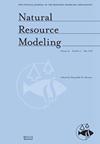Spatial and temporal zoning of watershed resilience using a multidimensional composition approach
IF 2.1
4区 环境科学与生态学
Q3 ENVIRONMENTAL SCIENCES
引用次数: 2
Abstract
The present initiative study has been planned to develop a conceptual model for watershed resilience for which rare documents have been reported yet, particularly in developing countries where such studies are necessary. In this vein, different ecological, social, economic, and infrastructural and cultural key domains were applied for the modeling processes of watershed resilience for the Shazand Watershed in Iran. To this end, watershed resilience was firstly conceptualized according to the prevailing conditions for three periods 1986–1998, 1999–2008, and 2009–2016. Accordingly, the watershed health index was used for the ecological dimension, and 13, 8, and 13 criteria were consequently considered for social, economic, and infrastructural and cultural dimensions, respectively. The whole data required for the last three dimensions were collected through the distribution of questionnaires among the stockholders of the Shazand Watershed. The principal component analysis (PCA) method was used to weighting and prioritize the criteria and dimensions. The overall resilience index was ultimately calculated by aggregating all four dimensions using a geometric mean. The effect of each dimension on resilience was also assessed by applying multivariable regression. According to the resilience map of the period 2009–2016, 40%, 9%, 34%, and 17% of the Shazand Watershed has been classified as very low and low resilience, moderate, high, and very high resilience. This study showed that the resilience of the Shazand Watershed has improved over time. The necessity of resilience modeling for practical and integrated management of watersheds was also confirmed during the present research.基于多维组合方法的流域恢复力时空分区研究
本倡议研究计划制定一个流域复原力的概念模型,迄今为止很少有文献报道,特别是在有必要进行此类研究的发展中国家。在这种情况下,不同的生态、社会、经济、基础设施和文化关键领域被应用于伊朗Shazand流域的流域恢复力建模过程。为此,流域恢复力首先根据1986年至1998年、1999年至2008年和2009年至2016年三个时期的主要条件进行概念化。因此,流域健康指数被用于生态层面,因此,社会、经济、基础设施和文化层面分别考虑了13、8和13标准。最后三个维度所需的全部数据是通过在Shazand流域股东中分发问卷收集的。主成分分析(PCA)方法用于对标准和维度进行加权和排序。总体恢复力指数最终是通过使用几何平均数将所有四个维度相加来计算的。还通过应用多变量回归评估了每个维度对复原力的影响。根据2009-2016年期间的恢复力图,沙赞德流域40%、9%、34%和17%的区域被划分为极低和低恢复力、中等、高和极高恢复力。这项研究表明,随着时间的推移,沙赞德流域的恢复能力有所提高。在本研究中,还证实了为流域的实际和综合管理建立复原力模型的必要性。
本文章由计算机程序翻译,如有差异,请以英文原文为准。
求助全文
约1分钟内获得全文
求助全文
来源期刊

Natural Resource Modeling
环境科学-环境科学
CiteScore
3.50
自引率
6.20%
发文量
28
审稿时长
>36 weeks
期刊介绍:
Natural Resource Modeling is an international journal devoted to mathematical modeling of natural resource systems. It reflects the conceptual and methodological core that is common to model building throughout disciplines including such fields as forestry, fisheries, economics and ecology. This core draws upon the analytical and methodological apparatus of mathematics, statistics, and scientific computing.
 求助内容:
求助内容: 应助结果提醒方式:
应助结果提醒方式:


